receive normal messages
Receive ordinary messages
##When ordinary WeChat users send messages to public accounts, The WeChat server packages the XML data of the POST message to the URL filled in by the developer.
Please note:
1. Regarding retry message duplication, it is recommended to use msgid to deduplicate messages.
2. If the WeChat server does not receive a response within five seconds, it will disconnect and re-initiate the request, retrying three times in total. If the server cannot guarantee to process and reply within five seconds,
can directly reply with an empty string. The WeChat server will not do anything with this and will not initiate a retry. For details, please see "Send a Message - Passive Reply to a Message".
3. If the developer needs to respond immediately to the user's message within 5 seconds, that is, when using the "Send Message-Passive Reply Message" interface to passively reply to the user's message, he can do so in
Message encryption is set in the Developer Center of the official website of the public platform. After encryption is turned on, messages sent by users and messages replied by developers will be encrypted (but messages sent by developers through API calls such as the customer service
interface will not be affected). For detailed instructions on message encryption and decryption, please see "Sending Messages - Passive Reply Message Encryption and Decryption Instructions".
The push XML data packet structure of each message type is as follows:
Text message
| ##<xml> <ToUserName><![CDATA[toUser]]></ToUserName>
<FromUserName><![CDATA[fromUser]]></FromUserName>
< ;CreateTime>1348831860</CreateTime>
<MsgType><![CDATA[text]]></MsgType>
<Content><![CDATA[this is a test]] ></Content>
<MsgId>1234567890123456</MsgId>
</xml>
|
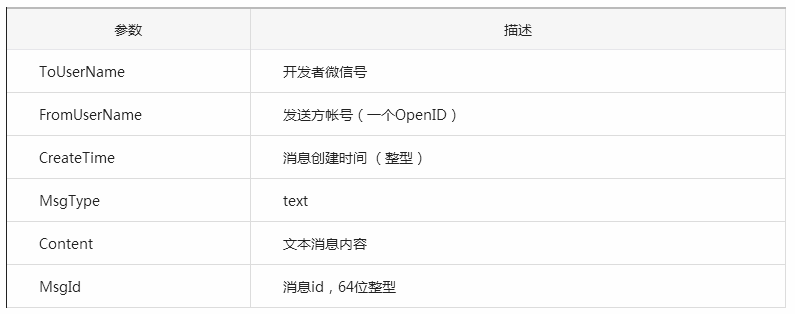
Use web debugging tools to debug this interface
Picture message
<xml>
<ToUserName><![CDATA[toUser]]></ToUserName>
<FromUserName><![CDATA[fromUser]]></FromUserName>
<CreateTime>1348831860</CreateTime>
<MsgType><![CDATA[image]]></MsgType>
<PicUrl><![CDATA[this is a url]]></PicUrl>
<MediaId><![CDATA[media_id]]></MediaId>
<MsgId>1234567890123456</MsgId>
</xml>
|
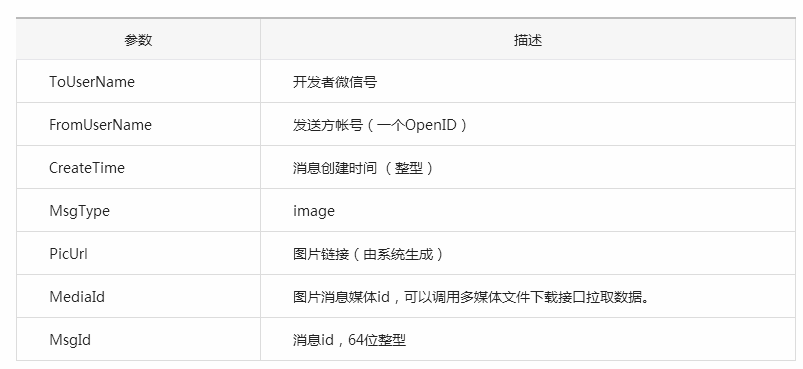
Use the web debugging tool to debug the interface
Voice message
<xml>
<ToUserName><![CDATA[toUser]]></ToUserName>
<FromUserName><![CDATA[fromUser]]></FromUserName>
<CreateTime>1357290913</CreateTime>
<MsgType><![CDATA[voice]]></MsgType>
<MediaId><![CDATA[media_id]]></MediaId>
<Format><![CDATA[Format]]></Format>
<MsgId>1234567890123456</MsgId>
</xml> |
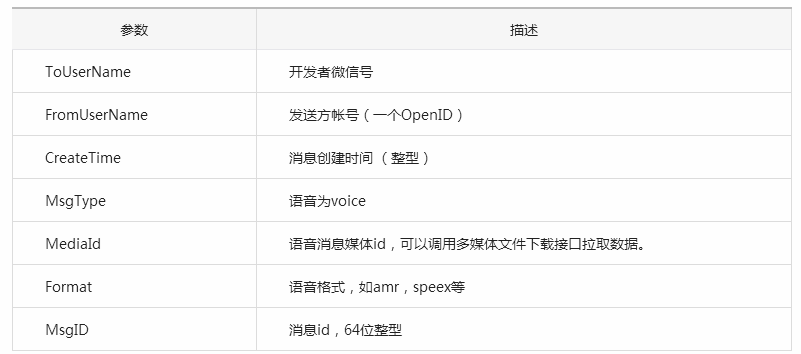
Use web debugging tools to debug this interface
Please note that after enabling speech recognition, every time a user sends a voice message to an official account, WeChat will add a Recongnition field to the pushed voice message XML packet (Note: Due to client caching, developers may enable or disable speech recognition. The function takes effect immediately for new followers and takes 24 hours for already followed users. Developers can re-follow this account for testing). The voice XML data packet after enabling speech recognition is as follows:
<xml>
<ToUserName><![CDATA[toUser]]></ToUserName>
<FromUserName><![CDATA[fromUser]]></FromUserName>
<CreateTime>1357290913</CreateTime>
<MsgType><![CDATA[voice]]></MsgType>
<MediaId><![CDATA[media_id]]></MediaId>
<Format><![CDATA[Format]]></Format>
<Recognition><![CDATA[腾讯微信团队]]></Recognition>
<MsgId>1234567890123456</MsgId>
</xml> |
Parameter description:

Video message
##<xml>
<ToUserName><![CDATA[toUser]]></ToUserName>
<FromUserName><![CDATA[fromUser]]></FromUserName>
<CreateTime>1357290913</CreateTime>
<MsgType><![CDATA[video]]></MsgType>
<MediaId><![CDATA[media_id]]></MediaId>
<ThumbMediaId><![CDATA[thumb_media_id]]></ThumbMediaId>
<MsgId>1234567890123456</MsgId>
</xml>
|

Use web debugging tools to debug this interface
Small video message <xml>
<ToUserName><![CDATA[toUser]]></ToUserName>
<FromUserName><![CDATA[fromUser]]></FromUserName>
<CreateTime>1357290913</CreateTime>
<MsgType><![CDATA[shortvideo]]></MsgType>
<MediaId><![CDATA[media_id]]></MediaId>
<ThumbMediaId><![CDATA[thumb_media_id]]></ThumbMediaId>
<MsgId>1234567890123456</MsgId>
</xml>
|
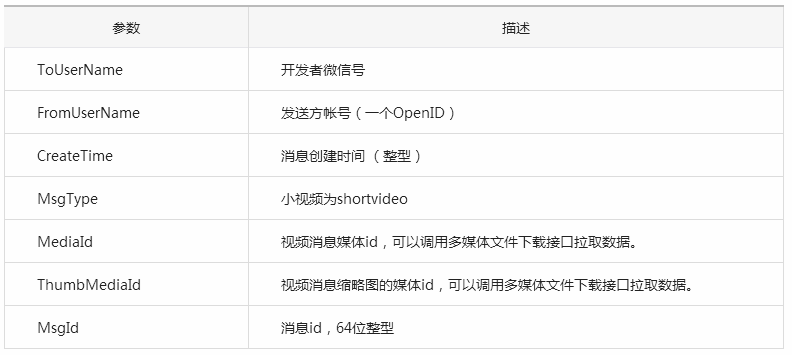
Use web debugging tools to debug this interface
Geolocation message <xml>
<ToUserName><![CDATA[toUser]]></ToUserName>
<FromUserName><![CDATA[fromUser]]></FromUserName>
<CreateTime>1351776360</CreateTime>
<MsgType><![CDATA[location]]></MsgType>
<Location_X>23.134521</Location_X>
<Location_Y>113.358803</Location_Y>
<Scale>20</Scale>
<Label><![CDATA[位置信息]]></Label>
<MsgId>1234567890123456</MsgId>
</xml>
|
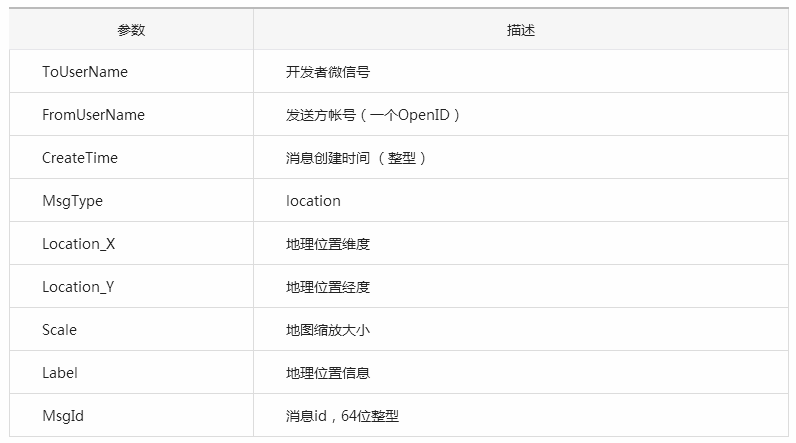
Use web debugging tools to debug this interface
Link message
<xml>
<ToUserName><![CDATA[toUser]]></ToUserName>
<FromUserName><![CDATA[fromUser]]></FromUserName>
<CreateTime>1351776360</CreateTime>
<MsgType><![CDATA[link]]></MsgType>
<Title><![CDATA[公众平台官网链接]]></Title>
<Description><![CDATA[公众平台官网链接]]></Description>
<Url><![CDATA[url]]></Url>
<MsgId>1234567890123456</MsgId>
</xml> |
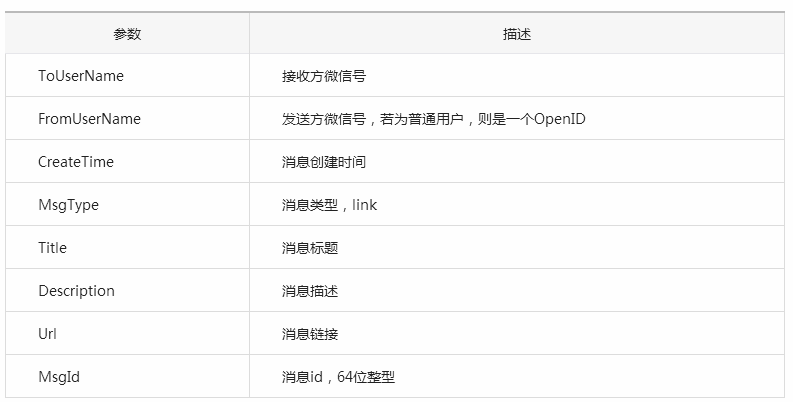
Use web debugging tools to debug this interface


















